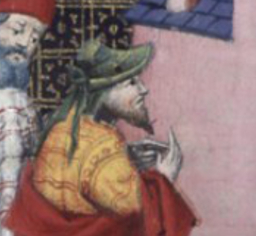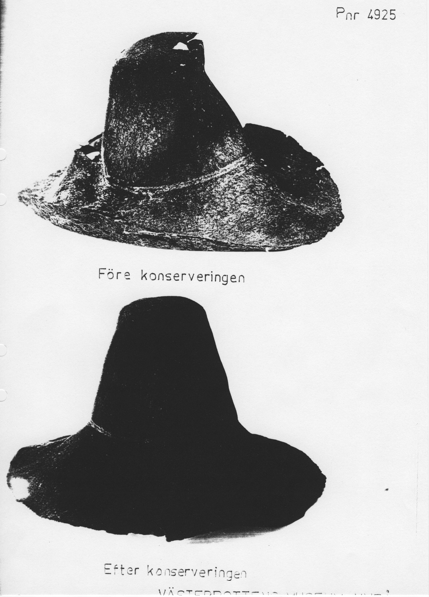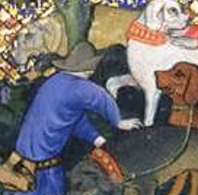This time we will go slightly of focus for the blog but we just have to put some light on this rather extraordinary well preserved medieval hat.
In 1938 they found an old hat. Its was a ordinary felted hat of 18 cm height and a brim with a 46 cm circumference. The hat emerged when a bog was being diked out. The special conditions of bogs can keep textile, especially wool, in a very good condition for a long time. Time went by and it was delivered to the local museum in 1966 where it was dated to around 1600 somewhere, mostly based upon its shape. The hat was carefully conservated and mounted. It was placed in its natural shape and not as it might have been worn. It has a rather distinct shape for 17:th century hats. In 2014 some workers at the museum had started wondering if the hat might not be older than this. A small piece was cut from the edge of the brim and sent for C14 dating. The test showed that it was from between 1310 and 1440, with a probability peak of around 1400. This makes it one of the best preserved medieval hats in Sweden, Scandinavia and possibly even Europe.
The northern reaches
Before we take a look at the hat, lets have a look on where it was found. The north part of the Scandinavian peninsula was at this time not part of any kingdom. Norway claimed some tax rights of the Sami people on the eastern sides. On the Baltic coast Swedish traders, so called birkarlar, where the only ones from Sweden allowed to trade with the Sami, a right they kept for a long time. Traders from Novgorod, the forerunners of the Russian empire, also came from the north to trade. The trade was almost exclusively with furs. Bisshunters (someone that hunts mainly for furs) and furtraders lived and traded here. The trade then moved over Stockholm, as this was a stapletown which all trade in the region had to go through. In Stockholm foreign traders would buy the goods and transport it out to the customers in Europe and the world. The area of Lappvattnet also had trade with the Norwegians, getting English goods from the Norwegian ports. This paints us a picture of a harsh pioneer frontier, but with connections to modern cities and fashion for those of means. The hat probably belonged to either a bisshunter or a furtrader. The name “Lappvattnet” means “the Sami water” Lapp, being an older term now considered derogatory. That the hat was found here, might implicate that the owner was part of the furtrade in some way.
The hat
The hat is extremely well preserved. As mentioned above it has a height of 18 cm and is slightly tapered to the top with a flat top. It gives a pointed look. Hat-maker and textile antiquarian Amica Sundström of the state historical museum thinks it was made on a stock, according to the surface of the hat. The brim is 46 cm wide. Over the brim we can see indentions from two cords. If these have been there as decorations or if they are marks from when the hat was made and tied down to the stock, is hard to know. Tying the hat to the stock under manufacture was not an uncommon practise. The hat is made from uncoloured sheepswool.
A look at other brimmed hats of the age
The hat does not look like a hat most people think of as medieval. But if you imagine it worn a bit different, it suddenly pops out of the sources as not very uncommon at all. Especially around the turn of the century 1300-1400. Most broadbrimmed hats are shown with the brim turned up, sometimes decorated. While most are roundtopped, there are some that have a clear point. Especially Russians in western art are depicted in pointy hats. These hats are somewhat more pointy as a rule, but there are all manners between round and pointy.

Russian bisshunters on Rigafahrergestühl St.-Nikolai-Kirche, Stralsund. These hats are very pointed and the brim uppturned all around.
The above picture is mostly to show pointy hats in the Baltic region. Other pointy hats in manuscripts have a more defined brim. Like these two, non russians, that we might suspect has this kind of hat in a more fancy version. The brim is turned up in the front and back. Note this for later. 

Hats with a more rounded top, but also higher then what would be called a roundtop can bee seen on more ordinary men, like this berner (doghandler) in Livre de chasse.
Something that looks quite similar to the Lappvattnet hat can be spotted on a fellow in the background of a illumination.  This pointed hat in a dark purplish hue could be worn with the brim upturned or not. the angle of the head makes it hard to judge.
This pointed hat in a dark purplish hue could be worn with the brim upturned or not. the angle of the head makes it hard to judge.
Also this hat from Another copy of livre the chasse shares characteristics to the Lappvattnet hat. The brim upturned and a pointed top.  All these hats are not quite spot on on the Lappvattnet hat, being to pointy or not pointy enough. But they serve the purpose of showing that brimmed hats with a pointed crown are not foreign to the age. But this hat with a fancy band on also sports the flat top of the hat combined with a brim and a tapered crown shape. I think that the Lappvattnet hat could be worn in a fashion like this and have a very similar look.
All these hats are not quite spot on on the Lappvattnet hat, being to pointy or not pointy enough. But they serve the purpose of showing that brimmed hats with a pointed crown are not foreign to the age. But this hat with a fancy band on also sports the flat top of the hat combined with a brim and a tapered crown shape. I think that the Lappvattnet hat could be worn in a fashion like this and have a very similar look. And then we have these two weary pilgrims from 1462. Having almost identical hats to the one from Lappvattnet
And then we have these two weary pilgrims from 1462. Having almost identical hats to the one from Lappvattnet 
The brimquestion
So, now we have looked at different hats and seen that the model is not all that uncommon. I have been thinking that the hats brim would have been worn turned up. This is of course also reflected in the picture-material I have presented to support this. There is also examples of wearing the hat with the brim down. This is mostly seen on pilgrims and other pious persons, but it is a possibility. Now lets look at the hat before and after preservation.  As we can see on the Before Picture (the topmost) the brims have a rather distinct upturn. Visible after some 500 years in a bog and 30 years above it. This curve could be from being in the bog, or from being badly stored after being taken up. But I find it quite possible that it is a upturn from its used days, based upon the pictures from the age showing that this is a very common way to wear it. The brim bears an uncanny resemblance to how the brim is used in the first pointy hats I posted above.
As we can see on the Before Picture (the topmost) the brims have a rather distinct upturn. Visible after some 500 years in a bog and 30 years above it. This curve could be from being in the bog, or from being badly stored after being taken up. But I find it quite possible that it is a upturn from its used days, based upon the pictures from the age showing that this is a very common way to wear it. The brim bears an uncanny resemblance to how the brim is used in the first pointy hats I posted above.
In conclusion
The Lappvattnet hat is a uniquely preserved hat for the common people. There is not many of these around, and the ones that are are not as well preserved as this one. If this was a hat for a more well positioned members of society it would probably have been dyed in some nice colour. That it is a plain undyed wool puts it in the lower layers of society.
We like to thank: Thank you to Västerbottens Museum for all the help they gave us. Especially Åsa Lundberg and Hillevi Wadensten. Also thanks to Amica at the state historical museum, textile antiquarian and hat reconstructor for some thoughts around it all. …and a personal thanks to Anna Söderström that pointed me towards the hat in the first place. You can read the museum report of the hat in Swedish here, pg 44 and 45. And the homepage of the museum is here, if you want to contact them. / Johan



Reblogged this on NorseWorks.
That was really interesting!
Yes, we thought so to!
At first we where all sceptical since wellpreserved hats usually just dont surface all of a sudden without a hullabaloo. But when we got to know the circumstances it was legit and i ws thinking “wow, we have nothing like this before up here”
As usual an eminent post! Now, who could make me one..?
Amica already made a testhat, as soon as the museum can give her the circumfence of the top and the bottom she can make one in earnest 😉
Oooh… I will have to sell my soul to the national museum of history then!
Oj vad kul, och det gömmer sig nog mycket fortfarande i arkiven! Minns f.ö att det fanns en läderhatt med brett brätte från samma period i Bergen när jag var där för tio år sedan.
Congratulations!
Marvelous, too often well meaning conservators failed in the life tests. As a supportable life style interpretation your work gets my nod of approval.
well, to their defence they thought its was a 17:th century hat. and as such, they mounted it very good 🙂
Great post, thank you for the information and pictures!
you are welcome. I am glad you found it useful 🙂
I totally did and I think I will make one based on this post! I have been wanting to make a hat to wear for everyday life that was period enough to fit medieval times as well (SCA) This will be perfect!
Thank you, so much! I really enjoyed to read all the story. I have wondered of some old wooden blocks, that I bought quite of time ago. They do have the pointed top, thought the bottom goes straight down. It´s NOT like the hat, that has been found. Seems, that this model has been used here ( in Finland) some time ago, for males. I do have these blocks of different circumstances and I didn, tknow, what to do with them. Now i can design something different and still modern 😉 I will publish this on my facebook pages https://www.facebook.com/hassuhatter and on my blog http://hassuhatter.blogspot.fi/. It was so interesting story.
Ah yes, it is of course the hat of Snusmumriken. Now we know he was more oldfashioned then we thought!
Reblogged this on SannoDesign.
Pingback: Klobúk z Lappvattnet | t e x t i l_restart
Hello, very nice and interesting article, so I translated it into slovak language and shared it on blog about conservation and restoration of textile materials. Have a nice day! Dominika.
How very nice!
its Always best when knowledge is shared and spread. Hoarded it is of Little use. 🙂
Pingback: Felt: Nature’s Nurture | The Æthelmearc Gazette
Pingback: Hats -do’s and don’ts | Exploring the medieval hunt
Superb post. Some of the other illustrations are very interesting – do you think you could start including details of such sources?
Pingback: O’Donovan notes: the calendar’s emblems – November and July. Pt.2 – Voynich Revisionist
Pingback: Six tips from the middle ages on how to beat the summer heat – We See & Show
Pingback: Six tips from the middle ages on how to beat the summer heat - Solutons Lounge